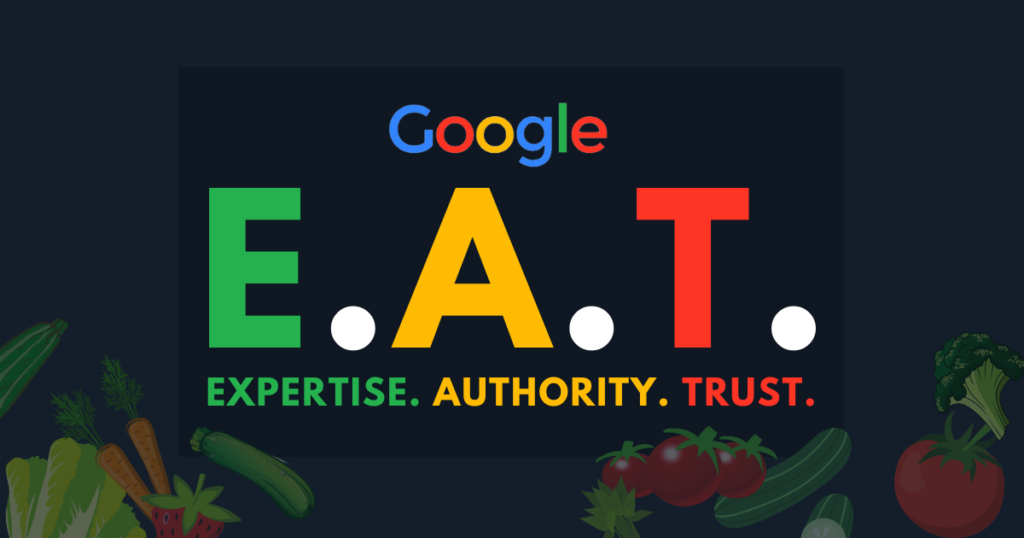If you’ve done any research on search engine optimization, E-A-T has probably popped up on your radar.
But what exactly is E-A-T, and how does it affect SEO?

What is E-A-T?
E-A-T (Expertise, Authoritativeness, and Trust) is part of a set of guidelines used by Google’s quality raters to determine the quality of a webpage (and, by extension, its content). It stands for expertise, authoritativeness, and trustworthiness.
These guidelines are primarily used to rate content but also extend to content creators. So the writer’s reputation can be just as important as having high-quality content.
The purpose of quality ratings is to deliver feedback that Google uses to measure algorithm performance. The rating itself doesn’t change or influence how a specific website ranks in the search results.
E-A-T is only a piece of what quality raters look at, but it’s a significant focus of the latest set of guidelines, which you can find here. E-A-T is even mentioned in parts of Google’s “How Search Works” page:
“Beyond matching the words in your query with relevant documents on the web, Search algorithms also aim to prioritize the most reliable sources available. To do this, our systems are designed to identify signals that can help determine which pages demonstrate expertise, authoritativeness, and trustworthiness on a given topic.”
So what can you do to help build expertise, authority, and trust, based on the information in these guidelines?
Get FREE Digital Marketing Courses and Tutorials Here!
#1 Be an expert on your topic, or compensate with high-quality content.
Google sees credentials and reputation as a big part of E-A-T, particularly when it comes to Your Money or Your Life (YMYL) topics, like the ones below:
- News and current events
- Civics, government, and law
- Finance
- Shopping
- Health and safety
- Groups of people
- Others, such as fitness, nutrition, job searching, college, and other topics that can have a major impact on someone’s life
For instance, articles that cover any medical advice should typically be written by someone with formal credentials or with their assistance, in addition to delivering high-quality content and citing other reputable sources.
It’s possible to cover YMYL topics without having formal credentials. However, you’ll want to approach it from a different angle—rather than delivering medical advice, people with “everyday experience” can create content based on their personal experiences.
While it’s more efficient to find a reputable author or industry expert, it’s not always a realistic expectation when you’re first getting your content off the ground. Writers can help “build” E-A-T by:
- Stating any credentials or experience in their author page, which could be their site or on a company page
- Creating unique, high-quality content that demonstrates knowledge or links out to other reputable resources
- Get links from reputable sites and pages to the content they’ve created, as well as their author page.
By working to increase the author reputation of both your writers and key people in your business, you’ll help improve your overall reputation and, more importantly, gain your readers’ trust.
What exactly does Google say about high-quality content?
There are a few key points in the evaluator guidelines that help us understand what determines high-quality content (referred to as main content or MC):
- Creating high-quality content takes some combination of time, effort, expertise, and talent/skill.
- Different types of content have different quality expectations. Informational content should be factually accurate, clearly written, and comprehensive. Shopping content should make it easy for readers to find products. Humor and satire don’t need to be factually based and should be entertaining.
- For some topics, the content has to be supported by expert consensus (especially in scientific and medical articles).
Some of this is a little subjective, but it does give us a good idea of what they’re looking for.
#2 Make it easy to learn more about your business and your writers.
Part of establishing trust with your readers is something simple that many businesses neglect:
Transparency.
Not only do readers want to find businesses with similar values, but they also want to learn more about your company.
Having clear policies is important, especially for e-commerce sites and other sites that collect user information.
Here are a few must-have’s for your site:
- About page
- Contact page
- Relevant policy pages (terms of service, privacy, product returns, etc.)
- Customer service information
Contact and clear customer service information is a must. Making it difficult for customers to reach you or not having a customer service presence can look shady in many situations and make it look like you’re evasive.
You’ll also want to have outside sources and references that mention your businesses.
Customers often go to outside sources to gather reviews and verify the legitimacy of your business, so it’s important to have at least a few quality mentions and links. It’s hard to build trust if you’re the only one talking about your company!
In addition, you’ll want to make it clear who’s creating your site content (or at least who’s overseeing it).
Having articles with no author or bio makes it difficult to gain more information about content production. While having high-quality content is key, content associated with more reputable sites and writers can often outperform even the best content.
While landing pages and other content aren’t expected to have this information, blog posts and other editorial content should have a visible author.
Many readers like to be able to connect with people, not a nameless, faceless corporation. In today’s busy online space, it’s easy to forget that there are people behind brands. They can lend voice and personality to your content.
#3 If you’re a writer, invest in personal branding.
With so much content available online, most of it gets swallowed up by the abyss and might never be seen again.
If you’re working with new sites, it isn’t easy to get content in front of the right people. Even with SEO, outreach, running social media ads, and other distribution efforts, it’s hard to stand out in today’s crowded digital space.
Imagine the added value you can bring to a new site if you already have a positive reputation, a decent social media following, and you have a loyal reader base who already trusts you.
By having clear, personalized branding, you bring another valuable asset to the companies you work with—an existing positive reputation and an online presence that makes it easy for raters (and readers!) to learn more about you. Being easy to find is another check in the E-A-T department.
#4 Revisit content that doesn’t perform well.
While you don’t want to go cutting pages left and right, it’s important to put your best foot forward with high-quality content.
If you have underperforming content that doesn’t do anything for your business, you’ll want to either edit it so that it meets performance standards or do away with it and redirect to a more relevant page.
In some cases (especially with YMYL content), you’ll want to hire an expert or industry leader to come in and work with a writer to revamp your content. This can be pricey but is absolutely worth it. You’ll give your readers the peace of mind that, even if you’re not an expert, you’re working with someone who is.
For pieces that don’t necessarily require formal credentials or industry experts, it might just be a case of rewriting content.
This could involve cutting the “fluff” and packing more information, editing for readability, or even just making sure your content has the most relevant, up-to-date information. (Think about how often content creators have to update how-to’s and tutorials on things like software and social media platforms that constantly get new updates from year to year!)
#5 Manage your company’s online reputation.
Part of building E-A-T is maintaining a positive reputation.
Raters specifically look for signs of a good reputation, rather than just having a reputation and high visibility in general. Even a complete lack of reputation is better than a negative one.
You’ll inevitably wind up with some upset customers and bad reviews, whether they’re warranted or not. The important part is that you take an active role in addressing negative interactions and doing what you can to correct them.
And I’ll be honest—reputation management is tedious. For some companies, it’s a full-time position (or even a team).
The worst thing you can do is ignore upset comments and reviews and make it look like you don’t care. How someone responds to these types of interactions speaks volumes about a business. (Have you ever avoided a company that fails to respond to reviews, or worse, puts the reviewers on blast?)
A negative reputation can spread like wildfire, especially if customers feel like their needs aren’t being met. By constantly managing reputation, you ensure things don’t spiral out of control, and your business maintains a positive reputation.
Final Thoughts
In this article, we covered:
- An overview of E-A-T
- An outline of high-quality content
- Some tips for building both author and webpage E-A-T
While E-A-T isn’t the final say in what kind of content gets a high rank in the search results, it certainly plays a big part in SEO and will likely become an even bigger part as more information is published online.
By publishing quality content, managing your business reputation, and supporting your writers as they grow and develop, you’ll find a place in today’s digital space and gain your audience’s trust over time.
The most important part is never overlooking what matters—your audience and the problems you’re solving! These guidelines are in place to help ensure a great experience for searchers and, by extension, your target audience.






